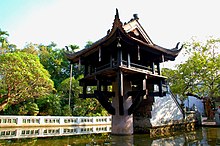One Pillar Pagoda
The One Pillar Pagoda ( Vietnamese Chùa Mot Cot ) or "One Pillar Pagoda", is one of the oldest pagodas in Hanoi . It is a landmark of the city because of its unusual construction. Originally built in 1049 by King Lý Thái Tông as a 3 m long wooden temple on a tree trunk, the reconstruction of the pagoda now stands on a concrete plinth protruding from the artificial lake.
history
According to legend, the goddess of mercy, Quan Âm (also Guanyin ), who was sitting on a lotus flower , appeared to the childless king Lý Thái Tông in a dream and presented him with a son. When he actually became the father of Lý Nhật Tôn a short time later (later ruler's name Lý Thánh Tông), he had this pagoda built in the form of a lotus flower out of gratitude. After it was destroyed several times, most recently by the French in 1954, the original tree trunk, which could no longer be saved due to rot, was replaced by a concrete column. The building rests on a concrete pillar in the middle of a small lake and can be reached by stairs for the faithful.
The pagoda was restored in 2014 and was only partially accessible during this time.
Web links
Individual evidence
- ↑ Minh Hang: The One Pillar Pagoda in Hanoi (also known as the “One Pillar Pagoda”) , report from April 23, 2014, accessed on June 24, 2015
Coordinates: 21 ° 2 ′ 8.7 ″ N , 105 ° 50 ′ 0.3 ″ E
